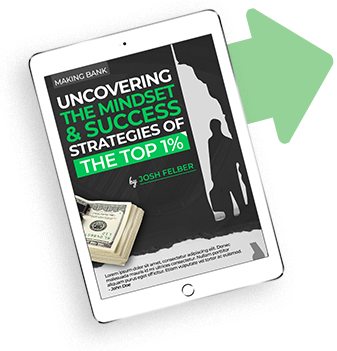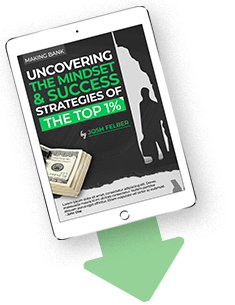The 5 Step Process that Wins Championships and Elections
with Phillip Stutts
Video:
Audio:
with guest Phillip Stutts #MakingBank S4E36
Phillip Stutts is not your average marketer, and he doesn’t design average marketing campaigns. How many marketing companies have you worked with who have 3 presidential election wins to their name? We’re guessing not many.
Thinking differently is a huge advantage in today’s world. Phillip brings a wealth of knowledge from his unique perspective of targeting audiences with deep insights from enormous data sets to the world of businesses marketing, and his approach has been a resounding success.
When he was developing this process he noticed something interesting. As he was looking around the world at successful organizations, he realized that many of them were using the same formula he was. Everyone from sports teams to lawyers to doctors were employing the same tactics to solving problems and becoming some of the most successful people or organizations in their respective fields.
He attests that using his process can eliminate a huge amount of risk for investors and really get into the heart of the issues he’s looking at. In his case, it’s how to market products to an audience, it used to be how to market candidates to voters, and it can be applied across a much wider spectrum.
If you follow his steps, he promises that you will be able to find success as well, and he detailed it for us in this week’s episode of the podcast as follows.
- Data
Step one is the backbone of Phillip’s strategy. Through massive data sets on the audience he is trying to reach, he builds a picture of what customers want and finds new angles for pitching products to them.
Let’s say you’re in the business of marketing music festivals. You probably know that most of your customers are between the ages of 21-35, but where are they? What social media platforms do they use? What are their preferences outside of festivals?
By delving into the data, you can find out where your audience is most active, who their favorite artists are, where they are in the world, and so much more. You may even find quirks that you could never have predicted and use those insights to design and market future shows.
Maybe a huge number of your audience are yogis, or love to paint. Maybe there’s a particular brand of sunblock they prefer or a line of beverages they would love to have featured at your events. It could be anything. The point is, when you dive into the data, you can take the guesswork out of designing products, events or services, and instead let the insights direct you.
Gone are the days when the Don Drapers of the world and a team of Ivy League intellectuals cook up magical marketing campaigns based solely off artistic instinct. In are the days when we have deep insights into the public we are trying to market to, and if you’re ignoring that data it doesn’t matter how insightful you are, you’re not going to be celebrating many victories in a penthouse with cigars and fine whiskey.
2. Strategic Marketing Campaign
Once you’ve combed through the data and found some insights, you will be able to build a marketing campaign with a much higher degree of accuracy in terms of speaking your target audience’s language. Figure out what are your 2 or 3 most powerful angles and get those creative juices flowing.
Phillip detailed working with a health supplement company and discovering through research that nearly 50% of their audience was vegan or vegetarian, and an astounding 75% hated soda. With this knowledge in hand, he was able to create simple campaigns that fell in line with these tastes, and they were a huge success. By understanding your target demographic on such an in-depth level, marketing campaigns nearly direct themselves.
3. Branding
Brands are so strong these days that it’s all most marketers think about. But this really shouldn’t come into play until you have mined the data and understood your audience. Branding is important, but what’s most important is that you’re showing up in google search results to a wide range of people. Once they’re drawn in, then tell them about your brand.
If you’re making conscious pet care products, first people need to know that you’re making good pet care products that your dog or cat will love. Next you can demonstrate that you’re ethical and environmentally conscious.
4. Low Cost Testing
Where many marketing agencies spend a small fortune testing their ad concepts, Phillip sees a different way. One of the most integral components of his 5 step process is low cost testing. As he states, banner ads are not really the best way to go for a full fledged campaign, but they are a good way to put some of your ideas to the test in an incredibly tough proving grounds.
Most people never click on banner ads, but even the stingiest of us may be swayed on occasion. If you are able to bring in a high percentage of clicks from a well targeted, low cost banner ad campaign, you’ll have a pretty good idea that a more robust campaign based on the same topics will be effective.
5. Launch
You’ve mined the data, you’ve gotten the insights. You’ve built a marketing campaign with your brand baked into it, and it’s past banner ad testing. You’re ready to fly, my friend.
After completing the first 4 steps, launching your campaign is a much more straightforward process that you can be more confident will return dividends.
How much time and energy could you save if you took all the guesswork out of marketing, and instead knew what your customers were likely to respond to? The best part is that this strategy is affordable for even small and medium sized businesses at just a $5,000 starting price. Given the benefit you get from taking this approach, can you really afford not to?
Topics
- Accelerated Learning
- Artificial Intelligence
- Become Present
- Blockchain
- Branding
- Business
- Education
- Entrepreneurship
- Family
- Finance
- Health
- Health & Wellness
- Internet Marketing
- Investing
- Leadership
- Lifecoach
- Marketing
- Negotiation
- Performance
- Productivity
- Publicity
- Real Estate
- Sales
- Sales Success Habits
- Video Marketing
- Writing

















